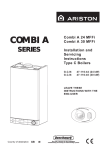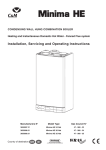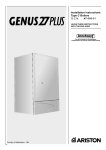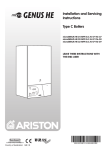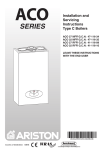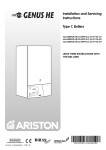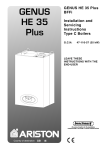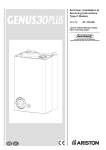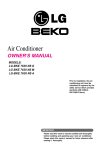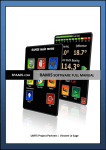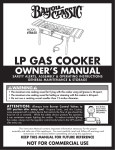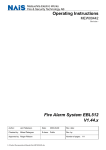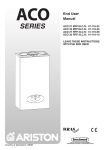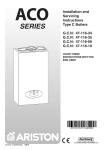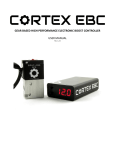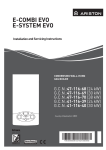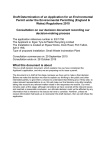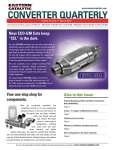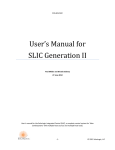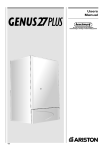Download Ariston Benchmark System A 30 RFF User's Manual
Transcript
SYSTEM A System A 24 RFFI System A 30 RFFI Installation and Servicing Instructions Type C Boilers G.C.N: G.C.N: 47-116-14 (24 kW) 47-116-15 (30 kW) LEAVE THESE INSTRUCTIONS WITH THE END-USER Country of destination GB IE These instructions are suitable for the System A boilers : MTS supports Benchmark, the heating industry code to ensure the correct installation, commissioning and servicing of domestic central heating systems. To The Householder Make sure that your installer completes Section 24 of this manual, this provides a record of the commissioning of your boiler. It contains important information about your particular installation that may be required by service engineers. It will also provide contact details for the installer should you need guidance in the use of this appliance or if there are any problems. As with your car, your boiler will work more reliably and efficiently if regularly serviced. We recommend an annual service check. The service history of the appliance must be recorded in Section 25 of this manual. In the unlikely event of any problems with your boiler or system you should first contact your installer. If your installer cannot resolve the problem he should telephone our national service helpline. A charge may be made if MTS Service is called out to resolve a non-product related fault. Your statutory rights are not affected. To The Installer As part of the commissioning of this appliance it is necessary to complete Section 24 of this manual and give this manual to the Householder. Please ensure that your customer is aware of the importance of keeping this manual safe as a record of the installation (Section 24) and the appliance service history (Section 25). Please ensure that your customer is aware of the correct operation of the system, boiler and controls. MTS recommend the use of protective clothing, when installing and working on the appliance i.e. gloves. CUSTOMER CARE MTS, as a leading manufacturer of domestic and commercial water heating appliances is committed to providing high quality products and a high quality after sales service. Advice on installation or servicing can also be obtained by contacting the Chaffoteaux Technical and Customer Service Departments on: TECHNICAL DEPARTMENT CUSTOMER SERVICE DEPARTMENT Tel: 0870 241 8180 Tel: 0870 600 9888 Fax: 01494 459775 Fax: 01494 459775 GUARANTEE The manufacturer’s guarantee is for 2 years from the date of purchase. The guarantee is invalidated if the appliance is not installed in accordance with the recommendations made herein or in a manner not approved by the manufacturer. To assist us in providing you with an efficient after sales service, please return the guarantee registration card enclosed with the boiler without delay. CAUTION In the United Kingdom, installation, start-up, adjustments and maintenance, must be performed by a competent person only, in accordance with the current Gas Safety (Installation & Use) Regulations and the instructions provided. In the Republic of Ireland, the installation and initial start up of the appliance must be carried out by a Competent Person in accordance with the current edition of I.S.813 “Domestic Gas Installations”, the current Buidling Regulations, reference should also be made to the current ETCI rules for electrical installation. All CORGI registered installers carry a CORGI ID card, and have a registration number. Both should be recorded in the Benchmark Commissioning Checklist (Section 24). You can check your installer is CORGI registered by calling CORGI direct on:- (01256) 372300. Improper installation may cause damage or injury to individuals, animals and personal property for which the manufacturer will not be held liable. To ensure efficient and safe operation it is recommended that the boiler is serviced annually by a competent person. If it is known that a fault exists on the appliance, it must not be used until the fault has been corrected by a competent person. 2 Contents CUSTOMER CARE Page Guarantee ............................................................................................................................................................2 Statutory Requirements .......................................................................................................................................2 Contents ...............................................................................................................................................................3 INTRODUCTION ..................................................................................................................................................4 USER’S INSTRUCTION .......................................................................................................................................5 1 CONTROL PANEL...........................................................................................................................................5 2 HOW TO USE .................................................................................................................................................6 Switching on ..........................................................................................................................................6 Time setting ............................................................................................................................................6 Heating ...................................................................................................................................................6 Burner ON................................................................................................................................................6 Stand by mode ........................................................................................................................................6 Switch OFF .............................................................................................................................................6 Anti freezing mode ..................................................................................................................................7 3 MAINTENANCE ..............................................................................................................................................7 4 GUARANTEE ..................................................................................................................................................7 5 PRACTICAL INFORMATION...........................................................................................................................7 6 SETTING THE TIME CLOCK ..........................................................................................................................8 6.1 SETTING THE MECHANICAL CLOCKS .................................................................................8 6.2 SETTING THE DIGITAL CLOCK..............................................................................................9 INSTALLERS’ INSTRUCTIONS.........................................................................................................................11 7 DESCRIPTION...............................................................................................................................................11 8 DIMENSIONS ................................................................................................................................................12 9 HYDRAULIC DATA .......................................................................................................................................12 10 INSTALLATION REQUIREMENTS................................................................................................................13 11 INSTALLING THE BOILER............................................................................................................................17 12 CONNECTING THE FLUE.............................................................................................................................19 12.1 FITTING THE COAXIAL FLUE .............................................................................................................20 12.2 FITTING THE 5” FLUE ..........................................................................................................................20 12.3 FITTING VERTICAL FLUE ....................................................................................................................22 12.4 FITTING THE TWIN FLUE ....................................................................................................................23 13 ELECTRICAL CONNECTIONS .....................................................................................................................26 14 COMMISSIONING AND TESTING ................................................................................................................32 14.1 INITIAL PREPARATION ........................................................................................................................32 14.2 INITIAL START-UP................................................................................................................................32 14.3 ADJUSTING THE CO2 ..........................................................................................................................33 14.4 GAS CONVERSION ..............................................................................................................................33 14.5 ADJUSTING THE MAXIMUM HEATING POWER ................................................................................33 14.6 FITTING THE EXTERNAL SENSOR.....................................................................................................33 14.7 EXTERNAL SENSOR SET-UP..............................................................................................................34 14.8 COMPLETION .......................................................................................................................................34 14.9 OPERATIONAL CHECKS .....................................................................................................................34 14.10 INSTRUCTING THE END USER...........................................................................................................35 15 FITTING THE CASING ..................................................................................................................................36 16 SEQUENCE OF OPERATION.......................................................................................................................37 CENTRAL HEATING MODE .................................................................................................................37 17 ADJUSTMENTS AND SETTINGS .................................................................................................................38 3 SERVICING INSTRUCTIONS 18 REPLACEMENT OF PARTS .........................................................................................................................45 18.1 To Gain General Access........................................................................................................................45 18.1.1 Removing the front panel.......................................................................................................................45 18.1.2 Lowering the control panel.....................................................................................................................45 18.2 Access to the Combustion Chamber .....................................................................................................46 18.2.1 Removing the combustion chamber front panel ....................................................................................46 18.2.2 Removing the burner .............................................................................................................................47 18.2.3 Removing the detection electrode .........................................................................................................47 18.2.4 Removing the ignition electrode.............................................................................................................47 18.2.5 Removing the fan...................................................................................................................................48 18.2.6 Removing the gas valve.........................................................................................................................48 18.2.7 Removing the heat exchanger ...............................................................................................................49 18.2.8 Removing the spark generator...............................................................................................................49 18.3 ACCESS TO THE WATER CIRCUIT ....................................................................................................50 18.3.1 Drain down.............................................................................................................................................50 18.3.2 Removing the 3 way valve.....................................................................................................................50 18.3.3 Removing the 3 way valve shutter.........................................................................................................50 18.3.5 Removing the pump...............................................................................................................................51 18.3.6 Removing the pressure relief valve ......................................................................................................51 18.3.7 Removing the domestic expansion vessel.............................................................................................52 18.3.8 Removing the overheat thermostat........................................................................................................52 18.3.9 Removing the temperature sensors (NTC’s) .........................................................................................52 18.3.10 Removing the pressure gauge...............................................................................................................53 18.3.11 Removing the DHW flow switch.............................................................................................................53 18.3.12 Removing & cleaning the condensate trap ............................................................................................53 18.4 ACCESS TO THE CONTROL SYSTEM ...............................................................................................53 18.4.1 Removing the PCB’s..............................................................................................................................53 18.4.2 Removing the fuses ...............................................................................................................................54 18.5 CONNECTING THE EXTERNAL SENSOR ..........................................................................................54 19 INCORRECT FUNCTION ......................................................................................................................55 20 GAS CONVERSION .............................................................................................................................56 21 INCORRECT FUNCTION ......................................................................................................................56 22 MAINTENANCE INSTRUCTIONS.........................................................................................................57 22.1 GENERAL REMARKS...........................................................................................................................57 22.2 CLEANING THE PRIMARY EXCHANGER ...........................................................................................57 22.3 OPERATIONAL TEST ...........................................................................................................................57 23 SHORT SPARES LIST ..........................................................................................................................58 24 TECHNICAL DATA ................................................................................................................................59 25 BENCHMARK COMMISSIONING CHECKLIST....................................................................................61 26 SERVICE INTERVAL RECORD ............................................................................................................62 INTRODUCTION The System A is a fully automatic, wall mounted, low water content condensing system boiler. It is a room sealed, fan assisted, balanced flued appliance providing central heating. It has electronic ignition and is suitable for all modern electrical control systems. The boiler is designed for sealed systems only and a circulating pump, expansion vessel together with a pressure gauge and safety valve are included within the boiler. The standard horizontal flue kit is suitable for lengths 300 mm minimum to 600 mm maximum and includes an elbow adapter that can be rotated through 360 ° . The horizontal flue can extend up to 3 metres using 1 metre flue extension kits. 45 ° and 90° flue bends are also available as accessories. The System A Plus includes a diverter valve and so can provide central heating and hot water flow for an indirect cylinder. 4 USER’S INSTRUCTIONS 1. Control panel 27 26 30 (System Plus only) 29 31 Fig 1 32 Control panel (fig. 1) 31.- Central Heating start button 32.- Menu button 33.- Reducing button 34.- Increasing button 35.- Setting button 34 35 Connecting bracket Taps shown in Open position (fig. 2) 26.- Display 27.- On/off push button and power on indicator light 29.- Reset push button and red indicator locking light 30.- Cylinder Hot water start button setting (System Plus only) 33 39 : Gas service tap 40 : Cylinder return valve (System Plus only) and temperature 41 : Central heating flow isolating valve and temperature setting 42 : Central heating return isolating valve 43 & 44: Filling taps 45 : Filling loop 41 40 42 43 Fig. 2 44 45 39 5 2. How to Use Switching on and filling instructions 1. Check the pressure in the central heating system is above 0.7 bar and below 1.5 bar with the pressure gauge 16 (fig.1), should it be neccessary to re-pressurise the system,ensure the filling loop 45 (fig. 2) is attached, open the filling taps 43 & 44, the pressure gauge will now start to rise, once the pressure reads 1.0 bar, close the filling taps and disconnect the filling loop. 2. Check that the gas service tap is opened at the gas meter and the main power is on. Green Power ON indicator 27 3. Open the gas tap 39 (fig.2). 4. The boiler is now ready to use. NOTE: If the boiler is left off for a long time, some air in the gas pipe can hinder the first lighting OPEN CLOSED attempts. (please refer to Section 19 Incorrect Function, page 47) + + Time setting You can set the time by using the keys underneath the display. for 5 seconds. The hour digits on the display will begin to flash. Set the correct time by using the or Press the setting key keys. To alter the minutes, press the setting key again, the minute digits will begin to flash. Set the correct time by using the or keys, once the correct time has been set, press the setting key once more to accept the time. Note: This is not a timer for Central Heating control. To obtain heating Turn the Central heating knob (30 Fig.1) between mini and maxi. During the setting flashes and displays the temperature the knob has been set to. The flashing will continue for a while after the setting and the display will then indicate one of the following : - the heating temperature when the room thermostat is ON (Calling). - the time when the room thermostat is OFF (Satisfied). Room thermostat request pictogram Tank pre-heating mode (System plus only) Turn the control knob 30 between min and max. During the adjustment, flashes. The flashing goes on for a while after the adjustment, then the display indicates the time. When DHW is drawn, the display indicates the following: Heating mode Turn the control knob 31 between min and max. During the adjustment flashes. The flashing goes on for a while after the adjustment, the display will then indicate: - the central heating flow temperature if the room thermostat is calling for heat. - the time if the room thermostat is OFF. Room thermostat request symbol BURNER ON and output level The flame digits will increase or decrease depending on the output. Flame digit Burner ON "Programming" button: button not activated, the domestic hot water exchanger temperature holding function is activated permanently. "Yellow" button activated, the temperature holding function respects the programme (11 p.m. OFF, 6 a.m. ON, original setting). The display indicates the following 6 Anti-freeze and anti-sieze modes Provided the ON/OFF button is on (green light), the water pressure is adequate and the boiler has not shut down due to an error, the anti-freeze and ant-sieze operations will remain active. . When the anti-freeze comes on, one of two codes will be displayed with the snowflake pictogram The two possible codes are 05 (pump anti-freeze) or 06 (burner anti-freeze). 05 (Pump anti-freeze): When the boiler senses a temperature of 8°C or lower, the pump will run for 2 minutes, the boiler will then check if the flow temperature is higher than 8°C. Should the temperature still be between 3°C and 8°C the above process will be repeated a maximum of 10 times, after this the burner will light and run until a temperature of 33°C is detected (see 06 Burner anti-freeze below). 06 (Burner anti-freeze): When the boiler senses a temperature of 3°C or lower, the boiler will fire at minimum power until a temperature of 33°C is achieved, the pump will run for 2 minutes after the burner is switched off. Anti-sieze mode The anti-sieze mode will activate the pump for 1 minute everytime the boiler has been inactive for 23 hours. Note: The anti-freeze and anti-sieze modes will be automatically overriden as soon as there is a demand for heaing from the room thermostat or cylinder thermostat. The anti-freeze functions will only protect the boiler from freezing, to protect the Central Heating system it will be necessary to leave the boiler powered, the Central Heating knob turned on and the room thermostat set to its anti-frost setting (usually between 5°C and 10°C). 3. Maintenance As with your car, your boiler will work more reliably and efficiently if regularly serviced. We recommend an annual service check. The service history of the appliance will be marked in the Service Interval Record (Section 25). 4. Guarantee The manufacturer`s guarantee is for 2 years from the date of purchase. The guarantee is voidable if the appliance is not installed in accordance with the recommendations made herein or in a manner not approved by the manufacturer. To assist us in providing you with an efficient after sales service, please return the guarantee registration card enclosed with the boiler without delay. 5. Practical information Cleaning the casing and control panel Should it be necessary to clean the casing and control panel, do so only with a damp cloth, do not use any spray polishes or cleaners. Precaution to avoid freezing We recommend that you contact your installer or local service centre for further advice on the actions to be taken to avoid the system freezing (should the boiler be turned off at the mains isolator) • CH system Choose one of the following solution : - 1) Drain the Central Heating system completely - 2) Protect the Central Heating system with anti freeze chemical products and periodically check the concentration - 3) Leave the Heating mode switched on and set the room thermostat to anti-freeze mode (between 5 and 10°C) - 4) Leave your boiler in stand-by mode, the anti-freeze device will switch on the pump and the burner if necessary. • DHW system Turn off the main cold water supply and drain the cylinder. 7 6. Setting the time clock 6.1 Setting the mechanical clock 12 9 3 6 Fig. 3 A 3 2 4 1 24 23 22 12 5 21 C 6 7 19 9 20 I 8 18 9 17 B 15 14 13 10 16 6 12 11 Fig. 4 1. General layout The mechanical clock covers a 24 hour period. Each tappet represents 15 minutes A (Fig. 4). An override switch is located on the clock B (Fig 4). 2. To set the time To set the time of day, grasp the outer edge of the dial and turn slowly clockwise until the correct time is lined up with the arrow C (Fig. 4). 3. To Set the "On" and "Off" times The clock uses a 24hours system. e.g. 8 = 8.00 am and 18 = 6.00 pm "ON" periods are set by sliding all tappets between the "ON" time and the "OFF" time to the outer edge of the dial.The tappets remaining at the centre of the dial are the "OFF" periods. 4. For operation symbol to control the central heating by the clock. Put the switch B to «I» to select Put the selector switch B to the permanent operation or to «0» to turn the central heating off permanently. 8 6. Setting the time clock (continued) 6.2 Setting the Digital Clock Manual switch Summer and winter time setting Reset Enter switching times h Prog . Enter the hours Weekdays flash m Imput time Enter minutes Day Enter weekday/s Automatic Operation Manual Operation Continuous Operation = ON = ON = Continuously ON = OFF = OFF = Continuously OFF The switching times correspond to the program entered. Operating the time switch The steps marked with the symbol “ If the current switching mode is changed manually, the next switching time will be carried out automatically again according to the entered switching program. You can only return to automatic mode from the continuously-ON and continuouslyOFF switching modes by pressing the " " key. ” are necessary to carry out a switching program. Preparing for Operation Activate the “Res” switch (=RESET) to reset the time switch to its default setting (activate using a pencil or similar pointed instrument). Do this: - every time you wish to “reset” the time switch - to erase all switching times and the current time of day. After approximately two seconds the following display appears: Enter current time and weekday - Keep the “ ” button pressed down During the summer time period press the +/- 1h button once. Enter the hour using the “h” button Enter the minutes using the “m” button Enter the day using the “Day” button 1 = “Monday”..............7 = Sunday - Release the “ ” button. 9 6. Setting the time clock (continued) Entering the switching times You have 20 memory Iocations available. Each switching time takes up one memory location. Keep pressing the “Prog” button until a free memory location is shown in the display “– –:– –”. ” button: Programme ON or OFF with the “ “ ”= OFF; “ ”= ON Enter the hour using “h” Enter the minutes using “m” If a switching command is to be carried out every day (1 2 3 4 5 6 7) then store using the “ ” button, otherwise select the day(s) it is to be carried out by using the “Day” button. When the day seIection is left bIank, the programmed switching instruction operates at the same time every day 1 2 3 4 5 6 = Monday – Saturday = Monday – Friday 12345 67 =Saturday – Sunday Selection of single days: 1 = Mon. .............. 2 =Tues. Save the switching time with the “ ” button. The time switch enters the automatic operating mode and displays the current time of day. Begin any further entry of a switching time with the “Prog” switch. If your entry is incomplete, the segments not yet selected will blink in the display. After programming is completed, and you return the time clock to the current time display with the “ ” button, the time clock will not activate any switching instruction required for the current time. You may need to manually select the desired switching state with the “ ” button. Thereafter, as the unit encounters further switching instructions in the memory in real time, it will correctly activate all subsequent switching instructions. Manual Override Switch “ ” With the “ ” you can change the current setting at any time. The switching program already entered is not altered. Reading the programmed switching times Pressing the “Prog” button displays the programmed switching times until the first free memory location appears in the display “– – : – –”. If you now press the “Prog” button once again, the number of free memory Iocations will be displayed, e.g. “18”. If all memory locations are occupied, the display “00” appears. Changing the programmed switching times Press the “Prog” button repeatedly until the switching time you want to change is displayed. You can now enter the new data. See point “Entering the switching times”. Notes on storing switching times: If you end your entry of the switching times by pressing the “Prog” button, then the switching time you have entered will be stored and the next memory location displayed. In addition, a complete switching command is stored automatically after around 90 seconds provided no other button is pressed. The time switch then enters the automatic operating mode and displays the current time again. Deleting individual switching times Press the “Prog” button repeatedly until the switching time you wish to delete is shown in the display. Then set to “– –” using the “h” or “m” button and keep the “ ” button pressed down for around 3 seconds. The switching time is now erased and the current time is displayed. AM / PM time display If you press the “+/-1h” and “h” buttons at the same time, the time display switches into the AM/PM mode. 10 INSTALLER’S INSTRUCTIONS 7. Description 1.- Steel chassis complete with expansion vessel 2.- Sealed chamber 3.- Burner and heat exchanger assembly 4.- Air / gas connection 5.- 24 V modulating fan 6.- Gas valve 7.- Ignition electrode 8.- Ionisation probe 9.- Ignitor 10.- Combustion products manifold 11.- Siphon 12.- Silencer 13.- Electrical box 14.- Pump 16.- Pressure gauge 17.- Three way valve 18.- Automatic air separator and automatic vent 20.- Main exchanger inlet thermistor 21.- Main exchanger outlet thermistor 22.- Overheat sensor 23.- Central heating pressure relief valve 24.- Manual air vent with pipe 25.- Thermo fuse 1 24 25 10 2 9 7 3 8 20 4 22 21 12 5 6 42 17 18 13 14 16 23 11 Fig. 5 Fig. 6 30 (System Plus only) 27 29 26 31 26.- Display 27.- On/off push button and power on indicator light 29.- Reset push button and red indicator locking light 30.- DHW control knob and temperature setting (System Plus only) 31.- Central Heating control knob temperature setting 32.- Menu button 33.- Reducing button 34.- Increasing button 35.- Setting button Fig. 7 32 33 34 and 35 11 8. Dimensions All dimensions in mm 289 21 Safety valve C/H and condensate Heating flow K Cylinder return (System Plus only) L Gas supply M Cold water supply N Heating return With packaging : 24 kW : 34 kg 30 kW : 37 kg 691,5 720 162 141 I J 172,5 121,5 4,7 I J KLM N I minimum space required 450 450 mini pour entretien 32 296 296 (24 kW) 360 (30 kW) 440 390 54 54 54 54 J K L M N Fig. 8 9. Hydraulic data The boiler is fitted with an automatic by-pass as standard. Pump Head Graph (15/50 & 15/60) The graph (Fig. 9) shows the development of the pressure available in relation to flow (on exit from the boiler ∆T 20°C). 0.45 0.4 Pressure (bar) 0.35 To ensure correct operation, the minimum flow of the appliance must be 300 l/h. (Thermostatic taps closed). 0.3 30 kW 0.25 Capacity of the installation. 0.2 The water heater is fitted with a pressurised expansion vessel. 0.15 0.1 24 kW Volumes : 0.05 6 litres Pressure: 0,7 bar. 0 200 0 400 600 800 1000 1200 1400 flow rate (l/hr) Fig. 9 The volume of the expansion vessel in a pressurised appliance varies according to: - the average operating temperature in °C - the static height, which is the difference in metres between the highest point of the appliance and the expansion vessel axis). Pression à froid pour le circuit chauffage (en bar) when cold (in bar) Central heating initial pressure Pf 2,0 The minimum cold filling pressure of the appliance is 1 bar (recommended pressure between 1.2 and 1.7 bar). 1,9 1,8 40°C The pressure of the expansion vessel should always be greater than the static height (in metres) divided by 10. 1,7 1,6 50°C 1,5 1,4 60°C 1,3 70°C 1,2 80°C 1,1 1,0 20 40 60 80 100 120 140 160 180 200 Capacité maximale de l'installation (en litres) System capacity chart 220 240 260 280 C litre Fig. 10 12 10. Installation Requirements Reference Standards In the United Kingdom, the installation and initial start up of the boiler must be by a CORGI Registered installer in accordance with the installation standards currently in effect, as well as with any and all local health and safety standards i.e. CORGI. In the Republic of Ireland the installation and initial start up of the appliance must be carried out by a Competent Person in accordance with the current edition of I.S.813 “Domestic Gas Installations” and the current Building Regulations, reference should also be made to the current ETCI rules for electrical installation. such as an outhouse or closed lean-to. Condensing boilers have a tendency to form a plume of water vapour from the flue terminal due to the low temperature of the flue gasses. The terminal should therefore be located with due regard for the damage or discolouration that might occur to buildings in the vicinity and consideration must also be given to adjacent boundaries, openable windows should also be taken into consideration when siting the flue. The minimum acceptable clearances are shown below: The installation of this appliance must be in accordance with the relevant requirements of the Local Building Regulations, the current I.E.E. Wiring Regulations, the by-laws of the local water authority, in Scotland, in accordance with the Building Standards (Scotland) Regulation and Health and Safety document No. 635, “Electricity at Work Regulations 1989” and in the Republic of Ireland with the current edition of I.S. 813 and the Local Building Regulations (IE). For detailed information on the installation of Condensing boilers, reference should be made to the ODPM Guide to the Condensing Boiler Assesment Procedure for Dwellings. C.O.S.H.H. Materials used in the manufacture of this appliance are nonhazardous and no special precautions are required when servicing. Codes of Practice Installation should also comply with the following British Standards Codes of Practice: BS 7593:1992 Treatment of water in domestic hot water central heating systems BS 5440-1:2000 Flues BS 5440-2:2000 Air Supply BS 5449:1990 Forced ciculation hot water systems Installation of gas fired hot water BS 6798:2000 boilers of rated input not exceeding 70kW BS 6891:1998 Installation of low pressure gas pipe up to 28mm IEE Wiring Regulations BS 7671:2001 BS 4814:1990 Specification for expansion vessels BS 5482:1994 Installation of L.P.G. E E Fig. 11 ABCDEFGHI J KL - Directly below an open window or other opening Below gutters, solid pipes or drain pipes Below eaves From vertical drain pipes and soil pipes From internal or external corners Above ground on a public walkway or patio From a surface facing a terminal From a terminal facing a terminal Vertically from a terminal in the same wall Horizontally from a terminal in the same wall Horizontally from an opening window Fixed by vertical flue terminal 300 75 200 75 300 2100 2500 2500 1500 300 300 NOTE: THE FLUE MUST NOT BE INSTALLED IN A PLACE LIKELY TO CAUSE A NUISANCE. It may be necessary to protect the terminal with a guard, if this is the case it will be necessary to purchase a stainless steel terminal guard. Reference should be made to the Building Regulations for guidance. Ventilation and in the Republic of Ireland in accordance with the following codes of practice I.S. 813 The room in which the boiler is installed does not require specific ventilation. If it is installed in a cupboard or compartment permanent ventilation is not required for cooling purposes. Domestic Gas Installations Avoid installing the boiler where the air inlet can be polluted by chemical products such as chlorine (swimming pool area), or ammonia (hair-dresser), or alkaline products (launderette) Gas Supply The gas installation and soundness testing must be in accordance with the requirements of BS 6891. Ensure that the pipe size is adequate for demand including other gas appliances on the same supply. Flue Detailed information on flue assembly can be found in Section 12 “Connecting the flue”. The boiler must be installed so that the flue terminal is exposed to the free passage of external air at all times and must not be installed in a place likely to cause nuisance. It must not be allowed to discharge into another room or space Electrical Supply The appliance requires an earthed 230V - 50 Hz supply and must be in accordance with current I.E.E. regulations. 13 10. Installation Requirements (continued) It must also be possible to be able to completely isolate the appliance electrically. Connection should be via a 3 amp fused double-pole isolating switch with a contact separation of at least 3 mm on both poles. Alternatively, a fused 3 Amp. 3 pin plug and unswitched socket may be used, provided it is not used in a room containing a bath or shower. It should only supply the appliance. The boiler is suitable for sealed systems only. The maximum working pressure for the appliance is 6 bar. All fittings and pipework connected to the appliance should be of the same standard. If there is a possibility of the incoming mains pressure exceeding 6 bar, particularly at night, then a suitable pressure limiting valve must be fitted. The boiler is designed to provide Central Heating on demand to a Central Heating system and to heat an Indirect Hot Water Storage Cylinder. Flushing and Water Treatment The boiler is equipped with a stainless steel heat exchanger. The detailed recommendations for water treatment are given in BS 7593:1992 (Treatment of water in domestic hot water central heating systems); the following notes are given for general guidance; If the boiler is installed on an existing system, any unsuitable additives must be removed. Under no circumstances should the boiler be fired before the system has been thoroughly flushed; the flushing procedure must be in line with BS7593:1992. We highly recommend the use of a flushing detergent appropriate for the metals used in the circuit. These include cleansers produced by Fernox and BetzDearborn, whose function is to dissolve any foreign matter that may be in the system; In hard water areas or where large quantities of water are in the system the treatment of the water to prevent premature scaling of the main heat exchanger is necessary. The formation of scale strongly compromises the efficiency of the thermic exchange because small areas of scale cause a high increase of the temperature of the metallic walls and therefore add to the thermal stress of the heat exchanger. Demineralised water is more aggressive so in this situation it is necessary to treat the water with an appropriate corrosion inhibitor. Any treatment of water by additives in the system for frost protection or for corrosion inhibition has to be absolutely suitable for all the metals used in the circuit. The use of a corrosion inhibitor in the system such as Fernox MB-1, BetzDeaborn Sentinel X100 or Fernox System Inhibitor is recommended to prevent corrosion (sludge) damaging the boiler and system; If anti-freeze substances are to be used in the system, check carefully that they are compatible with the metals used in the circuit. 14 MTS suggests the use of suitable anti-freeze products such as Fernox ALPHI 11, which will prevent rust and incrustation taking place. Periodically check the pH of the water/anti-freeze mixture of the boiler circuit and replace it when the amount measured is out of the range stipulated by the manufacturer ( 7 < pH < 8). DO NOT MIX DIFFERENT TYPES OF ANTI-FREEZE In under-floor systems, the use of plastic pipes without protection against penetration of oxygen through the walls can cause corrosion of the systems metal parts (metal piping, boiler, etc), through the formation of oxides and bacterial agents. To prevent this problem, it is necessary to use pipes with an “oxygen-proof barrier”, in accordance with standards DIN 4726/4729. If pipes of this kind are not used, keep the system separate by installing heat exchangers of those with a specific system water treatment. IMPORTANT Failure to carry out the water treatment procedure will invalidate the appliance warranty. Location The boiler can be installed on any suitable internal wall. Provision must be made to allow the correct routing of the flue and siting of the terminal to allow the safe and efficient removal of the flue products. A compartment or cupboard may be used provided that it has been purpose-built or modified for the purpose. It is not necessary to provide permanent ventilation for cooling purposes. Detailed recommendations are given in BS 5440 pt 2. If it is proposed that it is installed in a timber framed building then reference should be made to British Gas Document DM2, or advice sought from CORGI. Where a room sealed appliance is installed in a room containing a bath or shower, the appliance and any electrical switch or appliance control, utilising mains electricity should be situated specifically in accordance with current IEE Wiring Regulations. For unusual locations, special procedures may be necessary. BS 6798:2000 gives detailed guidance on this aspect. Condensate Discharge The condensate discharge hose from the boiler must have a continuous fall of 2.5o and must be inserted by at least 50mm into a suitable acid resistant pipe - e.g. plastic waste or overflow pipe. The condensate discharge pipe must have a minimum diameter of 22mm, must have a continuous fall and preferably be installed and terminated to prevent freezing. The discharge pipe must be terminated in a suitable position: i) Connecting into an internal soil stack (at least 450mm above the invert of the stack). A trap giving a water seal of at least 75mm must be incorporated into the pipe run, there also must be an air break upstream of the trap. ii) Connecting into the waste system of the building such as a washing machine or sink trap. The connection must be upstream of the washing machine/sink. If the connection is down stream of the waste trap then an additional trap giving a minimum water seal of 75mm and an air break must be incorporated in the pipe run, as above. 10. Installation Requirements (continued) iii) Terminating into a gully, below the grid level but above the water level. iv) Into a soakaway. fall. The total length of external pipe used should not exceed 3 metres. Some examples of the type of condensate terminations can be found below. NOTE: If any condensate pipework is to be installed externally then it should be kept to a minimum and be insulated with a waterproof insulation and have a continuous 1. 2. Internal termination of condensate drainage pipe to internal stack External termination of condensate drainage pipe via internal discharge branch (e.g. sink waste) and condensate siphon 15 10. Installation Requirements (continued) 3. External termination of condensate drainage pipe via internal discharge branch (e.g. sink waste - proprietary fitting) 4. External termination of condensate drainage pipe via condensate siphon 16 11. Installing the Boiler Please check that you are familiar with the installation requirements before commencing work (Section 10). The installation accessories described in the following list are included in the boiler packaging: - Hanging bracket - A paper template (showing the dimensions of the boiler with 5 mm side clearances) - Connection tails and valves - Screws and washers - Connection washers - Installation, Servicing and Operating Instructions - Air Inlet Header (for use with twin flue pipe) - Guarantee Card Method of positioning the boiler on the wall. The paper template can be used to ensure the correct positioning of kitchen cabinets etc. It also details the commissioning instructions. The paper template has to be fixed to the wall and used to locate the position of the hanging bracket and the centre for the flue hole. Drill and plug the wall and secure the hanging bracket using the screws provided. Remove the boiler from its packaging as shown in Fig. 12, unscrew the clamp locking bolt A and remove the casing (Fig. 13). Place the boiler on the wall on the hanging bracket (Fig. 14). NOTE: THE APPLIANCE MUST NOT BE FITTED ON A COMBUSTIBLE WALL SURFACE. Connecting the boiler to the system - Remove the boiler casing as described in Section 18. - Push in the tabs “P” (Fig. 14) on either side of the boiler and pivot the electrical box forward to gain access to the valve connections - Remove the caps and connect the valves to the boiler using the washers provided in the plastic bag. 2 x fibre washers for the C/H flow and return. 1 x rubber washer for gas connection Safety valve discharge The pressure relief valve tube is made of copper. It should terminate below the boiler safely outside the premises. Care should be taken that it does not terminate over an entrance or window or where a discharge of heated water could endanger occupants or passers by. Fill the Central Heating and DHW system and bleed air from the system as described in Section 14 . The system should be carefully checked for leaks, as frequent refilling could cause premature system corrosion or unnecessary scaling of the heat exchanger. The condensate pipe from the siphon (11 Fig. 6) should be connected to a drain as described in the relevant Brittish regulations. Pay special attention to not bend the plastic condensate drain pipe in such a way as to cause the flow to be interrupted. Please use exclusively drain pipe material compatible with condensate products. (refer to BS 6798 : 2000) The condensate flow can reach 2 litres / hour; because of the acidity of the condensate products (Ph close to 2), take care before operation. Fitting the Horizontal Flue Attention ! Before starting the boiler, the trap (11 Fig. 6) must be filled with water. Before fitting the flue onto the boiler, pour 1/4 litre of water into the exhaust pipe as shown in Fig. 15 (page 19). Instructions on fitting the flue can be found in Section 12. IMPORTANT!! Use only the specific condensation flue kit supplied by MTS (GB) Limited. 17 11. Installing the Boiler (continued) A A Fig. 12 1 2 Fig. 13 P P Fig. 14 Fig. 15 18 12. Connecting the Flue The boiler should only be installed with a flue system supplied by MTS (GB) Limited. These kits are supplied separately to the appliance in order to respond to different installation solutions. For more information with regard to the inlet/outlet accessories consult the accessory catalogue. The boiler is supplied ready for connection to a concentric flue system. NOTE: SEE PAGE 24 FOR MAXIMUM AND MINIMUM FLUE RUNS (TABLES A, B AND C) IMPORTANT!! BEFORE CONNECTING THE FLUE, ENSURE THAT 1/4 LITRE OF WATER HAS BEEN POURED INTO THE EXHAUST CONNECTION (FIG. 16). TO FILL THE CONDENSATE TRAP SHOULD THE TRAP BE EMPTY THERE IS A TEMPORARY RISK OF FLUE GASSES ESCAPING INTO THE ROOM. Fig. 16 Warning The exhaust gas ducts must not be in contact with or close to inflammable material and must not pass through building structures or walls made of inflammable material. When replacing an old appliance, the flue system must be changed. Important Ensure that the flue is not blocked. Ensure that the flue is supported and assembled in accordance with these instructions. Ø 60/100 mm 5 162 12 9 3 6 Fig. 17 118 Installation without extension 150 mm Fig. 18 Installation with extension slope * pente 150 mm *slope pente 5 mm par mètre 5 mm per metre 19 12.1 Fitting the coaxial flue (Ø 60/100 Horizontal) CONTENTS: 1X SILICONE O-RING (60mm) 1X ELBOW (90 ) 2X WALL SEALS (INTERNAL & EXTERNAL) 1X FLUE PIPE INCLUDING TERMINAL (1 METRE - 60/100) 1X FLUE CLAMP 1X SCREWS 1x Seal Once the boiler has been positioned on the wall, insert the elbow into the socket and rotate to the required position. possible to rotate the elbow 360o on its vertical axis. O NOTE: It is Using the flue clamp, seals and screws supplied (Fig 19) secure the elbow to the boiler. The 1 metre horizontal flue kit (3318073) supplied is suitable for an exact X dimension of 815mm. Measure the distance from the face of the external wall to the face of the flue elbow (X - Fig 17), this figure must now be subtracted from 815mm, you now have the total amount to be cut from the plain end of the flue. Draw a circle around the outer flue and cut the flue to the required length taking care not to cut the inner flue, next cut the inner flue ensuring that the length between the inner and outer flue is maintained. (Fig 19). e.g. X = 555mm 815-555 = 260mm (Length to be cut from the plain end of the flue). Once cut to the required length, ensure that the flue is free from burrs and reassemble the flue. If fitting the flue from inside of the building attach the grey outer wall seal to the flue terminal and push the flue through the hole, once the wall seal has passed through the hole, pull the flue back until the seal is flush with the wall. Alternatively, the flue can be installed from outside of the building, the grey outer seal being fitted last. Clamp Screws Seal Fig. 19 12.2 Fitting the 5” Flue (Ø 80 / 125 Horizontal/vertical) Should the flue require extending, the flue connections are push fit, however, one flue bracket should be used to secure each metre of flue. NOTE: SEE PAGE 24 FOR MAXIMUM AND MINIMUM FLUE RUNS. Once the boiler has been positioned on the wall, it is necessary to insert the Ø 80/125 adaptor (FIG. 20) for both horizontal and vertical flue runs into the boiler flue socket (not supplied with flue kit - Part No 3318095). Push the adaptor onto the boilers flue connection, grease the seals then add extensions or elbows as required, secure the adaptor, using the clamp and screws provided. To fit extensions or elbows it is first necessary to ensure that the lip seal is fitted correctly into the inner flue, once verified, it is simply necessary to push them together, no clamps are necessary to secure the flue components. Before proceeding to fit the flue, ensure that the maximum flue length has not been exceeded (See the tables on Page 23) and that all elbows and bends have been taken into consideration, the maximum flue length is 10 metres, for each additional 90o elbow 1 metre must be subtracted from the total flue length, and for each 45o 0.5 metres must be subtracted from the total flue length (the height of the vertical adaptor and a 45o bend can be seen in Fig. 21 and a 90o bend in Fig. 22). NOTE: DO NOT CUT THE VERTICAL FLUE KIT. 20 162 Fig. 20 Fig. 21 Fig. 22 21 12.3 Fitting the Coaxial Flue (Ø 60 / 100 Vertical) NOTE: SEE PAGE 24 FOR MAXIMUM AND MINIMUM FLUE RUNS. CONTENTS: 1X SILICONE O-RING (60mm) 1X CONICAL ADAPTOR (60/100mm) 1X VERTICAL FLUE KIT (80/125mm) 3X SCREWS The vertical flue kit is supplied with a specially designed weather proof terminal fitted, it can be used either with a flat roof or a pitched roof. The Vertical flue kits useable lengths with the pitched roof flashings are indicated in Fig. 23. Before proceeding to fit the flue, ensure that the maximum flue length has not been exceeded (See the tables on Page 24) and that all elbows and bends have been taken into consideration, the maximum flue length is 4 metres, for each additional 90o elbow 1 metre must be subtracted from the total flue length, and for each 45o 0.5 metres must be subtracted from the total flue length (the height of the vertical adaptor and a 45o bend can be seen in Fig. 24). Mark the position of the flue hole in the ceiling and/or roof (see Fig. 23 for the distance from the wall to the centre of the flue). Cut a 120 mm diameter hole through the ceiling and/or roof and fit the flashing plate to the roof. DO NOT cut the vertical flue kit. To connect the vertical flue kit directly to the boiler, place the vertical starter kit (Part No. 3318079) (see Figs. 23 and 24) onto the exhaust manifold and secure with the clamp, fit the vertical adaptor onto the vertical starter kit (note: there is no need to use a clamp to secure this as it is a push fit connection), the vertical flue kit must then be inserted through the roof flashing, this will ensure that the correct clearance above the roof is provided as the terminal is a fixed height. Should extensions be required, they are available in 1 metre (Part No. 3318077), 500mm (Part No. 3318078) and 160mm lengths, they must be connected directly to the vertical starter kit before connecting the adaptor to allow the vertical flue kit to be fitted. In the event that extension pieces need to be shortened, they must only be cut at the male end and it must be ensured that the inner and outer flue remain flush. When utilising the vertical flue system, action must be taken to ensure that the flue is supported adequately to prevent the weight being transferred to the appliance flue connection by using 1 flue bracket per extension. When the flue passes through a ceiling or wooden floor, there must be an air gap of 25 mm between any part of the flue system and any combustible material. The use of a ceiling plate will facilitate this. Also when the flue passes from one room to another a fire stop must be fitted to prevent the passage of smoke or fire, irrespective of the structural material through which the flue passes. 162 22 Fig. 23 Fig. 24 12. Connecting the flue (continued) 12.4 Fitting the twin pipe (Ø80/80) NOTE: SEE PAGE 24 FOR MAXIMUM AND MINIMUM FLUE RUNS (TABLE C) Where it is not possible to terminate the flue within the distance permitted for coaxial flues, the twin flue pipe can be used by fitting a special adaptor to the flue connector and using the aperture for the air intake located on top of the combustion chamber. Always ensure that the flue is adequately supported, avoiding low points. (MTS supply suitable clamps as Part No. 705778). To utilise the air intake it is necessary to: 1) Take the air intake cover off 2) Assemble the flange on the header supplied with the boiler 3) Insert the restrictor if necessary, on the tube or the elbow 4) Insert the header on the tube or the elbow up until the lower stop (you do not have to use the washer). 5) Insert the elbow/header in the boiler air intake hole and fasten it with screws The twin flue pipes can be fitted with or without additional elbows and need no clamps, simply ensure that the red o-ring is inserted in the female end of the flue pipe and push the extension piece fully into the previous section of flue pipe or elbow, check that the o-ring is not dislodged when assembling the flue. Twin pipe can also be converted back to Coaxial flue to enable vertical termination with a coaxial kit by using the pipe bridge (Twin - Coaxial Adaptor - Part No. 705767). When running the twin flue pipe vertically. It is not recommended that the pipe bridge for horizontal termination, however in the unlikely event that this proves to be a necessity it is extremely important that the entire flue has a fall of 5mm in every metre back to the boiler, and where the 60mm inner flue of the concentric terminal connects to the pipe bridge, this point must be adequately sealed with silicone sealant to avoid condense leakage at this point. When siting the twin flue pipe, the air intake and exhaust terminals must terminate on the same wall, the centres of the terminals must be a minimum of 280 mm apart and the air intake must not be sited above the exhaust terminal. The air intake pipe can be run horizontally, however, the terminal and the final 1 metre of flue must be installed with a fall away from the boiler to avoid rain ingress. It is also strongly recommended that the air intake pipe run be constructed of insulated pipe to prevent condense forming on the outside of the tube. The maximum permissible flue length for twin flue is dependent on the type of run used. For flue runs with the intake and exhaust pipes under the same atmospheric conditions (TYPE 4) the maximum length is 60 metres (24kW and 30kW), for runs with the terminals under different atmospheric conditions (TYPE 5) the exhaust terminal must extend 0.5 metres above the ridge of the roof (this is not obligatory if the exhaust and air intake pipes are located on the same side of the building). For TYPE 5 also, the maximum permissible combined length is 60 metres (24kW and 30kW). The maximum length is reached by combining the total lengths of both the air intake and exhaust pipes. Therefore a maximum length of 60o metres for example, will allow a flue run of 30 metres for the air intake and 30 metres for the exhaust pipes, also for each 90 elbow 2.2 metres must be subtracted from the total length and for each 45o elbow 1.4 metres must be subtracted from the total flue length. Some of the acceptable flue configurations are detailed page 24. For further information relating to flue runs not illustrated, please contact the Technical Department on 0870 241 8180. 230 MIN * 132 Fig. 25 162 162 200 123,5 B23 C53 Fig. 26 23 12.4 Fitting the twin pipe flue (Ø80/80) (continued) ø 100 123,5 107 200 25 Fig. 27 60 mm Fig. 28 In the event that twin flue pipes are used, and the boiler has a side clearance of less than 60mm from the wall, it is necessary to cut a larger diameter hole for the flue pipe, this should be ø10 cm, this will then allow for easier assembly of the air intake elbow and the tube outside the wall (see Fig. 28). TABLE A TABLE B TABLE C Concentric outlet 60/100 24 , 30 kW (Type 1, Type 2, Type 3) Concentric outlet 80/125 24 , 30 kW (Type 1) 24 , 30 kW (Type 2, Type 3) Twin flue outlet 24 , 30 kW Type 4 80/80 Type 5 80/80 Min length Max. length 0.3 m 10m Min length Max. length 0.3 m 30 m 0.3 m 35 m Min length Max. length Length equivalency for 45o 0.5 m elbow 90o 1m elbow 45o elbow 90o elbow 70 m (35m air / 35m exhaust) 70 m (35m air / 35m exhaust) 10 m 10 m 0.5 m 1m 45o elbow 90o elbow 1.4 m 2.2 m For coaxial systems, the maximum development value, mentioned in the table above also takes into account an elbow. For twin flue systems the maximum development value, mentioned in the table includes the exhaust gas/air intake terminal. Type 5 outlets should respect the following instructions: 1- Use the same ø 80 mm flue pipes for the gas intakes and exhaust gas ducts. 2- If you need to insert elbows in the gas intake and exhaust gas ducts, you should consider for each one the equivalent length to be included in the calculation of developed length. 3- The exhaust gas duct should jut above the roof by at least 0.5 m. 4- The intake and exhaust gas ducts in Type 5 must be installed on the same wall, or where the exhaust is vertical and the air intake horizontal, the terminals must be on the same side of the building. 24 70 140 60 120 50 100 40 80 30 60 Working area 20 40 10 20 0 0 0 10 20 30 40 Air inlet length in meter 50 60 Vertical flue exhaust length in meter Twin flue length diagram (24 and 30 kW) Horizontal flue exhaust length in meter Minima HE 24, 30 & 35 FF 12.4 Fitting the twin pipe flue (Ø80/80) (continued) TYPE 1 TYPE 4 TYPE 3 TYPE 2 TYPE 5 NOTE: DRAWINGS ARE INDICATIVE OF FLUEING OPTIONS ONLY. AIR INTAKE MUST NOT BE FITTED ABOVE THE EXHAUST AIR INTAKE EXHAUST AIR INTAKE Fig. 29 25 13. Electrical connections Making the Electrical Connections Hinge down the electrical box to gain access to the electrical connections. Push in the tabs P (Fig. 30) on either side of the boiler and pivot the box forward. Remove the PCB cover (see Section 18.4). Connect the live neutral and earth wires to the main cable. P If using a room thermostat or other external control, they can be connected in place of the link on the terminal block (Diagram A- Fig. 32). Note: Use only controls designed for voltage free switching or 24V supply. Do not connect to a 230V supply, and do not run 230v cables alongside the low voltage cables. P Fig. 30 All necessary settings for room thermostat operations are described in Section 17 ADJUSTMENTS AND SETTINGS. System A Plus System A D S F D Cylinder thermistor S F P2 P3 P2 P1 P3 P1 B4 B4 B3 B3 B2 B2 B1 B1 A4 A4 A3 A3 A2 A2 A1 ON A1 OFF ON J1 OFF J1 Cable 230 V 2P + T J12 J12 System A Plus change the EEPROM on PCB T 26 J1 J12 T J1 J12 4 LEGEND 1 1 2 3 4 5 6 7 8 9 10 11 12 13 14 15 3 2 15 NTC Connectors Display Connectors EEPROM Button 24V DC Supply Fan Connector Flame Detection Connector Fuses 2A 230V (X2) 230V Connector Auxillary 230V Connector Actuators 230V Connector Time Clock Connector (Internal) Room Thermostat Connector Remote Control Connector Under Floor Heating Connector Not Used Fig. 31 14 13 12 11 5 10 6 7 9 8 - If a remote time clock is to be fitted, using a volt-free switching time clock, remove the link wire and connect the switching wires from the time clock following points above (see also Diagram B Fig. 32). - If using an external time clock and room thermostat, remove the link wire and connect in series as above (see also Diagram C Fig. 32). Live and Neutral connections to operate the clock motor must be taken from a suitable source. Connector 11 (Fig. 31), is provided for connecting an optional integral time clock or programmer, for fitting instructions, please refer to those provided with the clock or page 8 of this manual. CONNECTOR 12 CONNECTOR 12 CONNECTOR 12 Fig. 32 27 13. Electrical connections (continued) 13.1 Fitting the mechanical and digital time clocks To fit the integral time clock it is necessary to proceed as follows; - Isolate the electical supply to the appliance; Remove the front panel as described in Section 18.1.1; Remove the plastic cover on the right hand side (Fig. 33) and pull out the 4 wires (Fig. 34); Connect the time clock wires as follows; MECHANICAL MODEL (Fig. 44) Red Wire Black Wire Black Wire Grey Wire - Contact 1 Contact 2 Contact 3 Contact 5 Fig. 33 NOTE: THE TWO BLACK WIRES ON CONTACTS 2 & 3 CAN BE REVERSED DIGITAL MODEL (Fig. 36) Red Wire Black Wire Grey Wire - Contact 1 Contact 2 Contact 3 NOTE: SECOND BLACK WIRE IS NOT CONNECTED. - Push the clock back into the panel and refit the casing panel (Fig. 37). Fig. 34 Fig. 35 5 4 3 G 2 B 1 R 3 2 G B Fig. 36 Fig. 37 28 1 R 13. Electrical Connections (continued) 13.2 Connecting Zone Valves (System A) The boiler can be connected to a central heating system that uses two zone valves to allow connection to an indirect storage cylinder. There are two wiring diagrams shown, one for the connection to an Unvented Cylinder (Diagram. A) and one for connection to an open vented cylinder (Diagram B). In both cases the boiler connection is shown as ROOM , which relates to the terminal on the PCB for external controls (see 12 FIG. 31). When connecting the boiler to an external cylinder do not run 240V cables and the cables for the ROOM terminal (Fig. 38) together, use separate cables to prevent induced voltage on the low voltage switching circuit. NOTE: THE USE OF A ‘Y’ PLAN SYSTEM IS NOT POSSIBLE WITH SYSTEM A BOILER DUE TO THE LOW VOLTAGE SWITCHING OF APPLIANCE. * THE THE * IMPORTANT!! ENSURE THAT A BALANCING VALVE IS FITTED ON THE CYLINDER RETURN AND BALANCED CORRECTLY AT COMMISSIONING STAGE. FIG. 38 29 WIRING DIAGRAM FOR CONNECTION TO AN OPEN VENTED CYLINDER 30 DIAGRAM B WIRING DIAGRAM FOR CONNECTION TO AN MTS UNVENTED CYLINDER DIAGRAM A 31 14. Commissioning and Testing 14.1 Initial preparation MTS (GB) Limited support the initiative. In Sections 24 and 25 (pages 60 and 61) of this manual the Commissioning Checklist and Service Interval Record can be found. It is important that this is completed in the presence of your customer, they are shown how to use it, and it is signed by them. Please instruct your customer that they must have this manual with them whenever they contact a service engineer or us. Preliminary electrical system checks to ensure electrical safety must be carried out by a competent person i.e. polarity, earth continuity, resistance to earth and short circuit. FILLING THE HEATING SYSTEM: Remove the front casing panel and lower the control panel as described in Section 18.1 (page 41). Open the central heating flow and return cocks supplied with the connection kit; Unscrew the cap on the automatic air release valve one full turn and leave open permanently; Close all air release valves on the central heating system; Gradually open the valves at the filling point (filling loop) until water is heard to flow, do not open fully; Open each air release tap starting with the lowest point and close them only when clear water free of air is visible; Purge the air from the pump by unscrewing the pump plug anti-clockwise, also manually rotate the pump shaft in the direction indicated by the pump label to ensure the pump is free; Refit the pump plug; Continue filling the system until at least 1.5 bar registers on the pressure gauge; Inspect the system for water soundness and remedy any leaks discovered. FILLING OF THE DHW SYSTEM: Close all hot water draw off taps; Open the cold water inlet cock supplied with the connection kit; Slowly open each draw off tap and close them only when clear water, free of bubbles, is visible. GAS SUPPLY: Inspect the entire installation including the gas meter and test for soundness. The entire installation should be in accordance with the relevant standards. In GB this is BS 6891 and in IE this is the current edition of I.S.813. The connection on the the appliance is a 15mm copper tail located at the rear of the gas service cock (39 Fig. 2 - page 5) If the gas supply serves other appliances, ensure that an adequate supply is available both to the boiler and the other appliances when they are in use at the same time. Pipe work must be of an adequate size. Pipes of less than 22mm should not be used. Open the gas cock (supplied with the connection kit) to the appliance and check the gas connection on the appliance for leaks. WATER TREATMENT: The boiler is equipped with a stainless steel heat exchanger. The detailed recommendations for water treatment are given in BS 7593:1992 (Treatment of water in domestic hot water central heating systems); the following notes are given for general guidance; If the boiler is installed on an existing system, any unsuitable additives must be removed; Under no circumstances should the boiler be fired before the system has been thoroughly flushed; the flushing procedure must be in line with BS7593:1992. Firstly fill the central heating system with the power off, and flush through cold, fill the central heating system again, adding a flushing detergent, run the boiler on central heating until it reaches its operating temperature and flush the system, refill the system with a suitable corrosion inhibitor, NOTE: FAILURE TO CARRY OUT THE FLUSHING PROCEDURE WILL RESULT IN THE WARRANTY BECOMING VOID. The checks to be run before initial start-up are as follows: 14.2 Initial start-up 1. Make sure that: - The screw on the automatic air valve has been loosened when the system is full; - CAUTION: It is very important to fully bleed the main heat exchanger of air when filling the boiler. You must continue to bleed the heat exchanger from the manual vent 24 (on the top of the heat exchanger), and pump through the automatic air vent 18 fig.6, through several central heating and hot water cycles to ensure the air is fully bled from the system. Close the manual vent after bleeding. 24 - If the water pressure in the system is below 1.5 bar, bring it up to the appropriate level; - Ensure that the gas cock is closed; - Make sure that the electrical connection has been made properly and that the earth wire is connected to an efficient earthing system; - Supply power to the boiler by pushing the on/off button 27 (Fig. 1) the green led indicator light will illuminate; - Turn the central heating control knob 30 (Fig. 1) to maximum and switch the time clock (if fitted) to constant and turn up the room thermostat (where fitted); - After 7 seconds, the boiler will signal a shutdown due to ignition failure. Leave the boiler as it is until all the air has been bled from the system; - Loosen the cap on the head of the pump to eliminate any air pockets; - Repeat the procedure for bleeding the radiators of air; - Open the hot water taps for a short period; - Check the system pressure and , if it has dropped, open the filling loop again to bring the pressure back up to 1.5 bar; 32 12 9 3 6 14. Commissioning and testing (continued) 14.3 Adjusting the CO2 14.4 Gas Conversion 2. Make sure that all radiator valves are open; 3. Turn on the gas cock and check the seals on the connections with any approved soap solution and eliminate any leaks; 4. Press the reset button 29 (Fig. 1) the boiler will re-attempt ignition. If the burner does not light the first time, wait 1 minute and repeat the procedure; 5. Check the minimum and maximum CO2 values and gas rates;- Adjust if necessary as indicated in Section 14.3 (page 29). To convert from Natural Gas (G20) to LPG (G31), it is necessary to insert a diaphragm and restrictor between the gas valve and air/gas arm. 14.3 Adjusting the CO2 1. Remove the casing panel as described in Section 18.1 (page 41); 2. Connect a manometer to the inlet test nipple on the gas valve, turn on a hot tap and ensure the inlet working pressure is 20mbar. If correct proceed as follows; 3. Turn on the combustion analyser, remove the combustion test point plug Q (Fig. 39) and insert the analyser probe into the test point; 4. Turn on a hot tap and ensure that the boiler is firing. 5. Access the setting menu by pressing the keys for 5 seconds the display; Once the conversion has been made, the CO2 setting will need to be checked as described in Section 14.3, for LPG the CO2 reading should be 10% +/- 0.2% with the front case fitted). To convert from LPG (G31) to Natural Gas (G20), it is necessary to remove the diaphragm and restrictor from between the gas valve and air/gas arm. Once the conversion has been made, the CO2 setting will need to be checked as described in Section 14.3, for NG the CO2 reading should be 9.2% +/- 0.2% (with the front case fitted). Adjustment screw and icon will be shown in the 6. Press the menu button four times to access Menu 5 and press the setting button once to switch the output of the boiler to maximum (two digits will be flashing indicating the temperature of the boiler). There will be a cursor at the top of the display indicating the boiler is at maximum output. If the cursor is at the bottom of the display (indicating minimum output) press the button the change to maximum output; 7. If necessary adjust the screw on the gas valve (Fig. 40) to set the CO2 to 8.9% +/- 0.2% (NG) or 9.7% +/- 0.2% (LPG); 8. Press the setting button once to set the combustion control rate mode to minimum, and, if necessary, adjust the screw on the gas valve to set the CO2 to 8.9% +/0.2% (NG) or 9.7% +/- 0.2% (LPG); 9. Press the setting button again to set the combustion rate control mode to maximum and if necessary adjust the screw on the gas valve to set the CO2 to 8.9% +/0.2% (NG) or 9.2% +/- 0.2% (LPG); 10. Reassemble in reverse order. Fig. 40 14.5 Range rating the maximum heating power To adjust the maximum heating power it is necessary to access the settings menu by pressing the and buttons together for five seconds, and proceed as follows; 1. Press the menu button 3 times to access Menu 4; 2. Press the button to access Menu 4.9; 3. The value is adjustable between 0 and 10, 0 being the minimum output and 10 being the maximum, please refer to the chart on page 32 (Fig. 43) for the required setting; 4. The maximum central heating output can now be adjusted by pressing the setting button ; 5. To exit the setting mode, do not press any buttons for 1 minute, the boiler will automatically exit the Setting Menu. 14.6 Fitting the external sensor The external sensor should be fitted 1.5 meters above the floor on a North to North West facing wall. Q Fig. 39 To connect the external sensor, it is first necessary to remove the casing panel as described in Section 18 (page 41); Remove the PCB cover as described in Section 18.4 and connect the external sensor as described in Section 18.5 (page 50). 33 14.7 External sensor and ambient sensor set-up (where fitted) N.B. To ensure that these parameters are set correctly, consult the "thermo-regulation help" document enclosed with the documentation folder. 14.8 Completion For the Republic of Ireland it is necessary to complete a “Declaration of Conformity” to indicate compliance to I.S.813. An example of this is given in the current edition of I.S.813. In addition it is necessary to complete the Commissioning Checklist in Section 24 of this manual (Page 60). 14.9 Operational checks 1. The system must be visually checked for soundness; 2. Fill the condensate trap with water, by pouring 1/2 litre of water into the exhaust flue connector (see Fig. 39). N.B. In the event of a prolonged period of system shutdown, the condensate trap should be filled before any renewed use. A shortage of water in the trap could possibly lead to a temporary leakage of fumes into the air, until it refills itself; 3. Ensure that the flue is fitted correctly; 4. Allow the central heating system to warm up and adjust the central heating temperature control knob 31 (Fig.1), check the burner modulates between the high and low settings; 5. Range rate the thermal power for central heating as detailed in Section 14.5. To adjust the maximum heating power it is necessary to follow the steps in Section 14.5 Menu 4. and adjust in relation to the chart on Page 35 (Fig. 42); Fig. 41 6. Check the gas rate; 7. Record the finding in the Benchmark Commissioning Checklist (Page 59); 8. Run the domestic hot water and adjust to the correct water flow rate, adjust the domestic hot water temperature control knob 30 (Fig.1) to ensure the burner modulates between the high and low settings; 9. Balance the central heating system until all return temperatures are correct and equal; 10. Turn the boiler off by pressing the On/Off button 27 (Fig.1) to OFF, disconnect the gas pressure gauge, retighten the screw and relight the boiler; 11. Re-examine the central heating, domestic hot water and old water supplies for soundness; 12. If external controls have been disconnected, reconnect and test; 13. Refit the boiler casing. 12 9 3 6 34 14. Commissioning and testing (continued) 14.10 Instructing the end user 1. Hand over these instructions and explain how to use the time clock and room thermostat (if fitted) and explain how to register the guarantee; 2. Show the end user how to switch the appliance off quickly, and indicate the position of the electric supply isolator; 3. Inform the end user of the location of all drains, isolating valves and air vents; 4. Explain how to turn the appliance off for both short and long periods and advise on the precautions necessary to prevent damage in the event that the appliance is inoperative when freezing conditions occur; 5. Instruct the end user on the correct procedure for checking and refilling the boiler; 6. Finally advise the end user that, for continued safe and efficient operation, the appliance must be serviced by a competent person at least once a year and the service logged in the Service Interval Record (Page 60). Central Heating Output average (kW) (30/50°C) 24 kW 23 30 kW 29 21.2 26,8 19.4 24,6 17.6 22,4 15.8 20,2 14 18 12.2 15,8 10.4 13,6 8.6 11,4 6.8 9,2 5 7 0 1 2 3 4 5 6 7 8 9 10 Steps (Value P min - P max - Menu 4) Fig. 42 35 15. Fitting the casing Fitting the casing Remove the protective film on the casing: - Locate the lower clips into the slots in the chassis - Engage hooks N on the casing in notches R on the side panels M operation (Fig. 43) - Fit the top of the panel in place - Close the panel mounting clamps (Fig. 44) - Screw in the two clamp locking bolts A Note: it is essential to refit both locking bolts A A M 1 R Fig. 44 Fig. 43 36 N 16. Sequence of operation Central Heating Mode Activation of the time clock and/or room thermostat starts the boiler. The display panel indicates the flow temperature s in central heating as illustrated below: Central heating mode ON Room thermostat contact ON With the boiler in rest, the diverter valve is in the domestic hot water position, activation of the central heating changes the position of the motorised valve head, moving the diverter valve into the central heating position. The start of the pump is delayed for 7 seconds to allow the movement of the diverter valve. The PCB checks the pressure of the primary circuit, if the pressure measured is 0.8 bar or lower, the boiler will lockout after 40 seconds. The error code E02 will appear on the LCD and the pump will stop. If the pressure measured is above 0.8 bar, the boiler ignition sequence will begin. At first, the fan starts and the speed increases to the required ignition speed (3460 rpm), once this speed has been achieved, the safety coil of the gas valve is supplied with 230V DC, after 8 seconds the boiler checks that the burner has lit, if the boiler does not sense that the burner has lit, the error code E04 will appear on the display, should this error occur, the boiler will attempt to relight two more times (20 seconds between each attempt). After this, should the boiler still not sense a flame, error code A03 will appear on the LCD. Should the boiler detect that the burner has lit, the boiler continues to regulate as follows. The NTC fitted on the outlet of the primary circuit exchanger is the only NTC to adjust the heat output of the boiler according to the adjustable setting point. This point is adjustable from 25°C to 85°C by the user. This NTC relays information to the PCB, which in turn modulates the burner by adjusting the speed of the fan. When the NTC senses that the set temperature has been achieved (+ 4°C to the temperature set by the user), the burner will go out. To avoid excessive burner lighting, an anti-cycle timer can be set between 0 to 7 minutes in menu 4 line 48 (see Section 17 Adjustments and Settings). The speed of the pump can be set at two levels. The PCB controls the speed of the circulation pump depending on the speed set in menu 4 line 41. Setting 410 will cause the pump to operate continually at high speed, and setting 411 will cause the pump to modulate between high and low speed depending on the ∆T between the inlet and the outlet. If the ∆T is greater than 20°C the pump will run on high speed and if the ∆T is less than 20°C the pump will run on low speed. NOTE: THE DEFAULT SETTING FOR THE PUMP IS HIGH SPEED. 37 17. Adjustments and settings 24 23 5 6 I 7 19 9 8 18 9 17 15 14 13 10 12 11 + button 16 6 P Reset push button - button 20 DISPLAY 1 12 21 On/Off push button Menu button 2 4 3 22 The boiler is delivered with pre-set values described in menus 3 and 4. All settings must only be changed by the installer or a qualified person. To gain access to the setting buttons please, open the front control panel cover P) and follow the instructions below. Setting button 2nd digit 3rd digit 1st digit 4th digit Pressing the, comfort, reset, menu, +, -, or setting buttons will make the display light. The light will go out 30 seconds after the last button has been pressed. To gain access to the setting menus press and buttons together for 5 seconds.. Menu 1 is displayed on the 1st digit. Changing the menu : Press the Menu button . The menu number is displayed for 3 seconds. Press the menu button to change to the next menu Setting a parameter in a section : Press the or button to change from between sections. Note : When you arrive at the last section of a menu, pressing the you are at the first section, pressing the button will change to the the 1st section. When button will change to the last section of the menu. Changing section in a menu (available only for menu 3,4,5 and 6) : Press the setting button to enter the modification mode, The 3rd and 4th digits will be flashing, press the or button to select the correct value then press the setting button to select this modification and to exit the setting mode. The 3rd and 4th digit stop flashing. Recalling the basic configuration : Select menu 3,4,5 or 6 then press the and buttons together for more than 5 seconds. The digits will flash CM for a while to indicate that the operation is completed. Clearing Menu 1 (default register) : Select menu 1 then press the and buttons together for more than 5 seconds. The digits will flash CM for a while to indicate that the operation is completed. Note : To exit install mode, press the Menu button returns to user mode. 38 for at least 3s. If no button is pressed for about 1 minute, the display ACTION DISPLAY CONFIGURATION Menu - 1 - Default register Record the last 10 defaults 5” Digit 1 Digit 2 Digit 3 and 4 Last default occured 1 0 code from 01 to 99 Last but one default occurred 1 1 code from 01 to 99 ... 1 ... code from 01 to 99 Last default occurred before the previous one 1 9 code from 01 to 99 Section x times Note -- is displayed if no default is recorded once Menu - 2 - Boiler conditions Indicates the conditions or the configurations of the boiler Section x times Digit 1 Digit 2 Digit 3 and 4 Software version of display PCB 2 0 code from 01 to 99 Software version of main PCB 2 1 code from 01 to 99 Flue type 2 2 4 : Condensation Fan speed (in hundreds of rpm) 2 3 from 01 to 99 Theoretical position of the 3 way valve System plus only 2 4 DHW flow temperature in °C 2 5 from 01 to 99 CH flow temperature in °C 2 7 from 01 to 99 CH return temperature in °C 2 8 from 01 to 99 Outside temperature in °C 2 9 from 01 to 99 0 : DHW 1 : CH 39 DISPLAY CONFIGURATION Factory setting ACTION Menu - 3 - Boiler options once Rubrique x times Elément 1 Elément 2 Inactive 3 0 DHW thermostatic kit fitted to boiler? (fix DHW temp to 65°C) 3 1 Elément 3 et 4 -- 0 : non 1 : oui 0: on heating and reheating of tank Optional programmer action 3 2 1: on reheating of tank 2: on the heating Inactive 3 3 -- Inactive 3 4 -- 3 5 0 to 5 mn by step 0,5 mn 3 7 -- DHW Delay (time before CH relight after a DHW cycle) Inactive 40 DISPLAY CONFIGURATION Factory setting ACTION Menu - 4 - Boiler settings once Section Digit 1 Digit 2 4 0 Digit 3 and 4 0 : no Stop pump after burner stops 1 : yes x times 0 : High speed Pump speed 4 1 1 : Adaptive 0 to 5 min by step 0.5 min Pump post circulation duration 4 2 Inactive 4 3 Maximum Central Heating flow temperature 4 4 Minimum Central Heating flow temperature 4 5 Inactive 4 6 Inactive 4 7 CH anti-cycling delay 4 8 0 to 7 min by step 0.5 min CH maximum output (range rating) 4 9 Value from 0 to 10 Pmin & Pnominal 50° to 85° by steps of 1° 25° to 50° by steps of 1° 41 ACTION DISPLAY CONFIGURATION Menu - 5 - Combustion rate control mode Effect Display once Combustion rate control mode OFF Combustion rate control mode ON The main exchanger temperature appears on the display. The digit - on the display shows the gas output level. (Top = maxi, bottom = mini). Gaz output setting To modify the gas output use + and buttons. once x times To cancel the combustion rate control mode press button “Menu”. The combustion rate control mode will be inactive when : - boiler is in stand by mode - heating mode with room thermostat and initial heating temperature reaches max. heating recommendation - boiler in lockout mode - after the default settings have been restored or if the main supply fails (power cut) - if the operator exits the 5th menu - after 5 minutes if no buttons are pressed Note : As soon as the combustion rate control mode is active, the Central Heating and Domestic Hot Water control knobs become inactive. 42 DISPLAY CONFIGURATION Factory setting ACTION Menu - 6 - Thermo-regulation settings once Section Digit 1 Digit 2 Digit 3 and 4 0: Heating setting can be adjusted by the user 1: Variable heating setting depending on the external temperature x times Type of control 6 0 2: Variable heating setting depending on the room temperature (Clima Manager)* 3: Variable heating setting depending on the external and room temperatures (Clima Manager)* Compensation 6 1 If or 00 to 20 in intervals of 1 Slope 6 2 Parallel shift 6 3 If or 0.3 0.5 1.0 1.2 1.5 2.0 2.5 3.0 If or from - 20 to 20 in intervals of 1 Inactive 6 4 -- Inactive 6 5 0 Inactive 6 6 -- Inactive 6 7 -- Inactive 6 8 -- Inactive 6 9 -- * Available only with Clima Manager N.B. To ensure that these parameters are set correctly, consult the "thermo-regulation help" document enclosed with the documentation folder. 43 17. Adjustements and Setting (continued) CH anti cycling delay setting : If you would like to change the setting of CH anti cycling delay, if you want 3 mn ,please proceed as follow : (note : the factory setting is 2 mn 30 seconds and the following explanation refer to menu 4 section 8) Display 1 Switch to installer mode, press button and 1 5” for 5 seconds, the display shows :10=0 if there is no default in the default register. 2 Press 3 times on menu button to 2 gain access to menu 4, the display x3 shows : 40=0 or 40=1 or 3 Change for section 8 (CH anti cycling delay), press on button 3 side x8 times , the display shows :48=2.5 (factory setting 2 mn 30 s) 4 = menu 4 8 = section 8 2.5 = 2,5 mn (2 mn 30 secondes) 4 Press on setting button one time, the 3rd and 4th digits flash together, Then press on to change the CH anti cycling delay, the display shows : 48=3.0 press on setting button to confirm the value. The display stops flashing. Setting procedure is finished. To exit from setting mode, leave the boiler for approx. 1 minute then the computer will switch back to user mode. After programming please close the door P (fig. 48) 44 4 SERVICING INSTRUCTIONS A To ensure efficient safe operation, it is recommended that the boiler is serviced annually by a competent person, refer to Section 20 (page 53) for the Servicing Schedule. Before starting any servicing work, ensure both the gas and electrical supplies to the boiler are isolated and the boiler is cool. Before and after servicing, a combustion analysis should be made via the flue sampling point. After servicing, preliminary electrical system checks must be carried out to ensure electrical safety (i.e. polarity, earth continuity, resistance to earth and short circuit). IMPORTANT! AFTER AN ANNUAL SERVICE, THE SERVICE INTERVAL RECORD (SECTION 25, PAGE 60) MUST BE COMPLETED. Fig. 45 18. Replacement of parts The life of individual components vary and they will need servicing or replacing as and when faults develop. The fault finding sequence chart in Section 19 will help to locate which component is the cause of any malfunction, and instructions for removal, inspection and replacement of the individual parts are given in the following pages. Fig. 46 18.1 To Gain General Access All testing and maintenance operations on the boiler require the control panel to be lowered. This will also require the removal of the casing. 18.1.1 Removing the front panel : 1. Remove the security screw and unlock the two case locking catches A (see Figs. 45 & 46); 2. Remove the front panel from the rest of the casing (see Fig. 47). 18.1.2 Lowering the control panel : Fig. 47 1. Remove the front panel; 2. Unlock the two clamps locking and pivot the electrical box downward (see Fig. 48). Fig. 48 45 18.2 Access to the Combustion Chamber 18.2.1 Removing the air gas assembly 1. Isolate the gas supply to the boiler; 2. Carry out step 18.1.1; 3. Remove the silencer (Fig. 49); 4. Disconnect the detection electrode cable (Fig. 50); 5. Remove the earth cable from the ignition electrode (Fig. 51), and remove the ignition electrode cable from the ignitor (Fig. 52) Fig. 51 Fig. 50 Fig. 49 6. Unplug the gas valve and fan connectors (Figs. 53 and 54); Fig. 52 Fig. 54 Fig. 53 7. Unscrew the 4 nuts D on the combustion chamber (Fig. 55); 9. Remove the air gas assembly and combustion chamber front (Fig. 57); 10. Reassemble in reverse order. 8. Unscrew the gas valve nut E (Fig. 56); E D Fig. 55 Fig. 56 Fig. 57 46 18.2.2 Removing the burner Do not remove the burner unless absoluly necessary. 1. Carry out step 18.1.1 and 18.2.1 (without removing the 4 nuts D); 2. Remove the 3 screws F from the air/gas manifold (Fig. 58); 3. Slide the burner out from the front, taking care not to damage the insulation (Fig. 59a 24 kW & 59b 30 kW); 4. Reassemble in reverse order and checking all seals are undamaged and the burner is positioned correctly (Fig. 60). If necessary, replace the insulation too. D Fig. 59a F Fig. 59b Fig. 58 Fig. 60 18.2.3 Removing the detection electrode 1. Carry out step 18.1.1; 2. Disconnect the detection electrode cable (Fig. 61); 3.Remove the 2 screws G from the electrode manifold (Fig. 62); 4. Pull the electrode from the combustion chamber (Fig. 63); 5. Reassemble in reverse order. G Fig. 62 Fig. 61 Fig. 63 18.2.4 Removing the ignition electrode 1. Carry out step 18.1.1; 2. Remove the earth cable from the electrode (Fig. 64); 3. Remove the electrode cable H from the ignitor (Fig. 65); 4. Unscrew the 2 screws I on the electrode (Fig. 66); H I Fig. 64 Fig. 65 Fig. 66 47 18.2.5 Removing the fan 1. Carry out step 18.1.1; 2. Remove the air gas manifiold as in step 18.2.1 (Fig. 67); 3. Unscrew the two screws from the venturi J and remove with the gas valve (Fig. 68); 4. Unscrew the three screws K on the air/gas pipe and remove (Fig. 69); 5. Reassemble in reverse order. K J Fig. 67 Fig. 68 Fig. 69 18.2.6 Removing the gas valve 1. Carry out step 18.1.1; 2. Remove the air gas manifiold as in 18.2.1 (Fig. 70); 3. Unscrew the three screws L on the air/gas pipe and remove (Fig. 71); 4. Unscrew the three screws holding the gas valve on the venturi (Fig. 72); L Fig. 70 5. Remove the gas valve from the venturi. (Fig. 73); 6. Reassemble in reverse order; 7. The gas valve settings will need to be adjusted (see Section 14.3 page 28); 8. Reinstate the gas supply and test for tightness on reassembly. Fig. 73 48 Fig. 71 Fig. 72 18.2.7 Removing the heat exchanger 1. Carry out step 18.1.1; 2. Remove the air gas manifiold as in 18.2.1 (Fig. 74); 3. Remove the flow pipe clip and unscrew the pump nut (Fig. 75a & 75b); 4. Remove the flow and return pipes and the condense drain pipe from the heat exchanger. (Fig. 75c); Fig. 75a Fig. 74 Fig. 75b 5. Remove the two bolts securing the exchanger (Fig. 76); 6. Remove the screw M2; then rotate clockwise the bearing frame (Fig. 77); Fig. 75c 7. Remove the heat exchanger by slightly rotating. (Fig. 78); 8. Reassemble in reverse order. M2 M1 Fig. 76 Fig. 77 Fig. 78 18.2.8 Removing the spark generator 1. Carry out step 18.1.1; 2. Disconnect the ignition electrode, live, neutral and earth cables from the ignitor (Fig. 79); 3. Remove the screw N from the ignitor and remove (Fig. 80); 4. Reassemble in reverse order. N Fig. 79 Fig. 80 49 18.3 Access to the Water Circuit Important! Before any component is removed, the boiler must be drained of all water. 18.3.1 Drain down Close the flow and return isolating valve and open the pressure relief valve. 18.3.2 Removing the 3 way valve 1. 2. 3. 4. 5. 6. Carry out step 1.2.1 and 1.2.3; Remove the clip “Q1” from the by-pass tube (see fig. 87); Remove the clip “Q2” and “Q3” from the heating return and the pump (see fig. 88 & 89); Remove the two T25 screws “P1” (see fig. 87); Remove the 3 way valve body pulling it toward you (see fig. 90); Reassemble in reverse order; P1 Q2 Q1 Fig. 87 Fig. 88 Q3 Fig. 90 Fig. 86 Fig. 89 18.3.3 Removing the 3 way valve shutter 1. Carry out step 1.2.1 and 1.2.3; 2. Unscrew the two CHC screws “R”(see fig. 91); 3. Remove the 3 way valve shutter pulling it up (see fig. 92) R fig. 91 fig. 92 50 4. Reassemble in reverse order; 18.3.5 Removing the pump 1. Carry out step 18.1.1; 2. Lower the electrical box cover as in step 18.1.2; 3. Remove the PCB cover; 4. Remove the pump plug from the control board and earth plug from earth socket (see Fig. 93); 4. Unscrew the pump nut (see Fig. 94); Fig. 93 5. Remove the clip S2 on the pump volute (see Fig. 95); Fig. 94 6. Pull the pump toward you and remove the clip S3 securing the pressure gauge (see Fig. 96); 7. Reassemble in reverse order. S2 S3 Fig. 96 Fig. 95 18.3.6 Removing the pressure relief valve 1. Carry out step 18.1.1 and 18.3.1; 2. Remove the clip securing the valve (see Fig. 97) and pull it toward you; 3. Reassemble in reverse order; take care to ensure the valve is in the correct position; Fig. 97 51 18.3.7 Removing the expansion vessel 1. Carry out step 18.3.1; 2. Isolate the gas supply and disconnect all pipe connections; 3. Remove the boiler from the wall 4. Unscrew the nut U (see Fig. 98); 5. Pull the expansion vessel to remove it (see Fig. 99); 6. Reassemble in reverse order. U Fig. 98 18.3.8 Removing the overheat thermostat 18.3.9 Removing the temperature sensors (N.T.C’s) 1. Remove the casing as in step 18.1.1; 2. Pull off the thermostat connections. Then remove the thermostat from the pipe by releasing it’s securing clip (see Fig. 100). 1. Remove the casing as in step 18.1.1; 2. Pull off the NTC connections. Then remove the NTC from the pipe by releasing it’s securing clip (see Fig. 101). Fig. 100 52 Fig. 99 Fig. 101 18.3.10 Removing the pressure gauge 18.3.11 Removing the water pressure switch 1. Carry out step 18.4.6; 2. Remove the pressure gauge by releasing the two clips V and pulling the pressure gauge out. (see Fig. 102) 1. Remove the casing as in step 18.1.1; 2. Pull off the connections. Then remove the pressure switch by releasing it’s securing clip (see Fig. 103). V Fig. 102 Fig. 103 18.3.12 Removing & cleaning the condensate trap 1. Unscrew the cap of the condensate trap (see Fig. 104) 2. Empty the condensate products and rinse the condensate trap with clean water (see Fig. 105) 3. Reassemble in reverse order and fill the condensate trap with 1/2 litre of water before restarting the boiler. Fig. 105 Fig. 104 18.4 Access to the Control System 18.4.1 Removing the P.C.B.s 1. Carry out steps 18.1.1 and 18.1.2; 2. Remove the screw W1 from the electrical box (see Fig. 106); 3. Release the three clips W2 and remove the electrical box cover (see Fig. 107); W1 W2 Fig. 106 Fig. 107 53 4. Remove the two screws W3 from the front control panel and lower the front control panel (see Fig. 108); 5. Remove all electrical connections from the display PCB (see Fig. 109; W3 Fig. 108 6. To remove the display PCB, remove the two screw W3 and lift the PCB out (see Fig. 110); 7. Reassemble in reverse order; Fig. 109 8. To remove the main PCB disconnect all electrical connections and remove the two screws W5 (see Fig. 111); Do not forget to swap the EEPROM button when removing the old PCB in order to replace it on the new one. 9. Reassemble in reverse order. W4 W5 Fig. 110 Fig. 111 18.4.2 Removing the fuses 18.5 Connecting the external sensor 1. Carry out step 18.4.1; 2. Remove the fuses “X” (see Fig. 112) 3. Reassemble in reverse order. 1. Reach to the main PCB as in step 18.4.1; 2. Install the interface module supplied in the kit on the main PCB (see Fig. 113) 3. Connect the wires between the external sensor and the interface (see Fig. 113). NOTE: FUSE RATING = 2AMP FAST FUSE X Fig. 112 54 Fig. 113 19. Incorrect function In case of problem, or when the boiler has displayed an error code, the display flashes 2 digits. Please refer to the table below to diagnose the fault. For faults 01 and 03, A appears on the display, the boiler is locked and the reset button illuminates (28). To reset the boiler press the reset button 29. 29 Overheating lock out FAULT Fig. 114 Code Fault description A 01 Overheating lock out / Heat exchanger thermo fuse A 03 No flame after safety timer A 18 3 "flames in progress" disappearances in 1 operating cycle A 37 CPU fault A 39 MCU fault 1 A 40 MCU fault 2 A 41 Fan error E 02 Pump protect (display after 40s.) E 04 No flame detection E 05 Anti freezing system, pump on E 06 Anti freezing system, pump and burner on E 07 No water circulation in primary circuit E 08 No water in the primary circuit E 09 DHW sensor open circuit E 10 DHW sensor short circuit E 11 Flow sensor open circuit E 12 Flow sensor short circuit E 13 Return sensor open circuit E 14 Return sensor short cir
































































